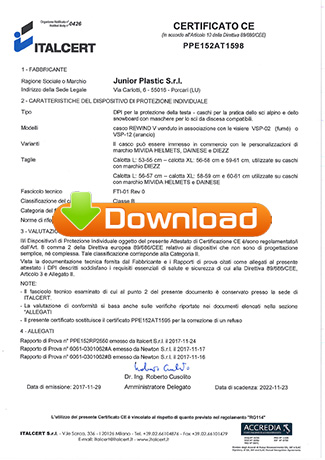


SKI HELMETS CERTIFICATION
Our helmets are produced according to EN 1077/2007 norms.
Our helmets are tested and certified by CSI Spa- Viale Lombardia, 20 - 20021 Bollate - Milano
LAB TESTS PROVIDED FOR BY NORM:
Test verifying helmet capacity for shock absorption
Helmets are treated in three different ways:
1. At ambient temperature (+20° C. for min. 4 hrs)
2. At low temperature (-25° C. for min 4 hrs)
3. By artificial aging (to temp. of 70° C. for min. 48 hrs and U.V. exposure for 48 hrs)
Subsequently the helmet is positioned on a false head of proper size and knocked in pre-determined areas. Impact is made on a flat anvil at 5,42 m/s speed.
Test verifying resistance to penetration:
Helmet must stand to penetration by a cone-shaped piercing punch. Piercing punch has an angle of 60° and a weight of 300 gr.
Piercing punch falls down from 750 mm. height and must not get in touch with false-head.
Test verifying the retention capacity of strap:
With this test retention capacity of strap and buckle are determined by means of a dynamic force of 15 kgs. falling down from 200 mm. height.
Test of undermining:
Helmet must stand to a dynamic force given by a 10 kgs weight falling down from 175 mm. height.
MOTORCYCLE HELMETS CERTIFICATION
Our helmets are produced according to ECE 22/05 norms.
Our helmets are tested and certified by NEWTON S.R.L. Via G. Di Vittorio 2/D 20017 Mazzo di Rho (MI)
LAB TESTS PROVIDED FOR BY NORM:
Test verifying helmet capacity for shock absorption
Helmets are wetted with solvents and are treated in five differents ways:
- at ambient temperature (25° c.) and at relative humidity of 65% for min. 4 hours
- at heat (+50° c. for min. 4 hours)
- at low temperature (-20° c. for min. 4 hours)
- exposed to U.V. for min. 48 hours
- in contact with water at ambient temperature for min. 4 hours.
Subsequently, helmet is positioned on a false head and shocked frontally, side, top and back and on the chin guard ( when on the helmet or in case of a full face helmet). Impact is on a flat anvil and on a kerbstone anvil (kerbstone anvil must have a 105° angle)
Test verifyng the friction on a surface
Helmet runs over an abrasive plane with the dynamic force of 15 Kg. weight falling down from 500 mm. height. Helmet must not stop on the abrasive plane.
Test verifying the retention capacity of strap:
With this test retention capacity of strap and buckle are determined by means of a dynamic force of 10 kgs. falling down from 750 mm. height.
Test of undermining:
Helmet must stand to a dynamic force given by a 10 kgs weight falling down from 500 mm. height.
